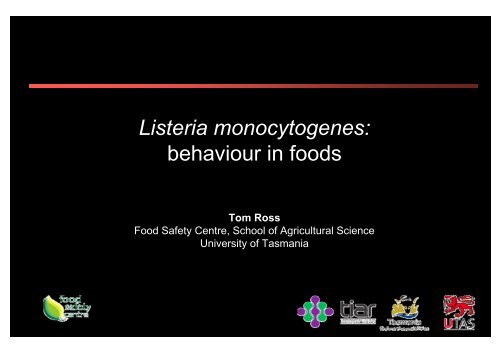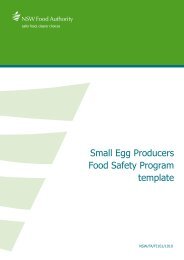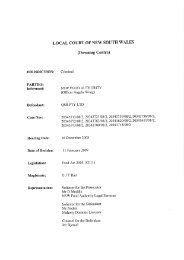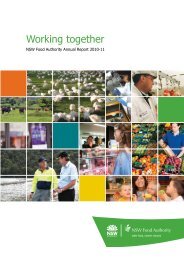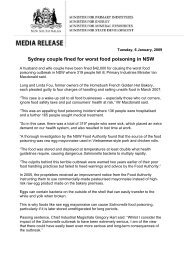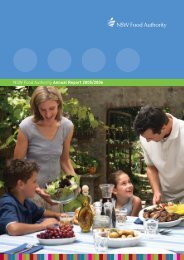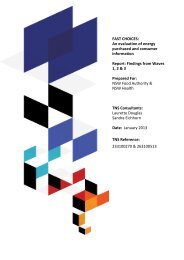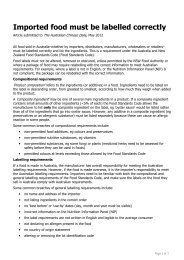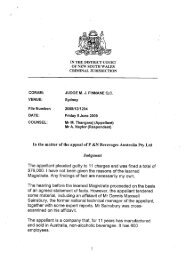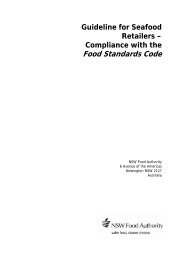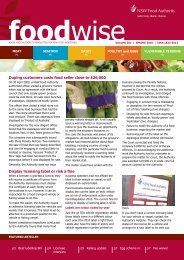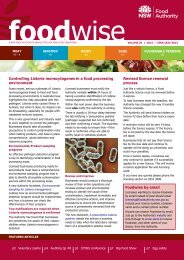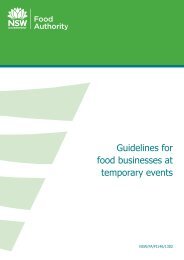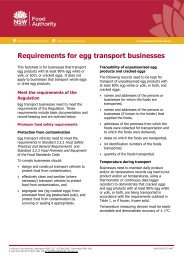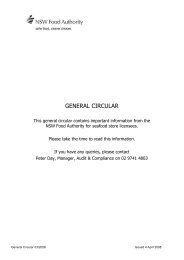Survival of Listeria in processed meat and poultry products
Survival of Listeria in processed meat and poultry products
Survival of Listeria in processed meat and poultry products
You also want an ePaper? Increase the reach of your titles
YUMPU automatically turns print PDFs into web optimized ePapers that Google loves.
<strong>Listeria</strong> monocytogenes:<br />
behaviour <strong>in</strong> foods<br />
Tom Ross<br />
Food Safety Centre, School <strong>of</strong> Agricultural Science<br />
University <strong>of</strong> Tasmania
overview<br />
• some more epidemiology<br />
– dose-response relationships<br />
– susceptibility<br />
• eco-physiology <strong>in</strong> foods/factories<br />
– growth rates<br />
– growth limits<br />
– effect <strong>of</strong> lactic acid bacteria<br />
– the Hurdle Concept<br />
• predict<strong>in</strong>g growth <strong>and</strong> growth limits under multiple<br />
environmental constra<strong>in</strong>ts<br />
<strong>Listeria</strong> Summit, Sydney, 2010
epidemiology
epidemiology<br />
• 85% <strong>of</strong> cases have known predispos<strong>in</strong>g factors<br />
• very young, old, pregnant, immunocompromised are most<br />
susceptible<br />
• 3 - 10 cases per million per annum <strong>in</strong> developed nations (Oz: 60<br />
- 80 cases/year)<br />
• 25-35% mortality<br />
• virtually all cases believed to be food-borne<br />
<strong>Listeria</strong> Summit, Sydney, 2010
elative susceptibility<br />
Susceptibility relative to<br />
healthy young adult<br />
Transplant recipients 2,584<br />
AIDS patients 865<br />
Pregnant woman 10 - 40<br />
Per<strong>in</strong>atal <strong>and</strong> neonates 839<br />
Dialysis 476<br />
Cancer 70 to 110<br />
Over 65 years 7.5<br />
<strong>Listeria</strong> Summit, Sydney, 2010
chang<strong>in</strong>g epidemiology <strong>in</strong> Australia<br />
<strong>Listeria</strong> Summit, Sydney, 2010
“<strong>in</strong>fectious dose”
dose-response<br />
• methods <strong>of</strong> estimation<br />
– no ‘volunteer’ trials<br />
– animals models (rats, pregnant rhesus monkeys, pregnant gu<strong>in</strong>ea pigs)<br />
– epidemiology<br />
– “reverse” exposure assessment<br />
• <strong>in</strong>fectious dose varies<br />
– by consumer<br />
– by stra<strong>in</strong><br />
– by cell ‘history’ (food type, food process<strong>in</strong>g)<br />
<strong>Listeria</strong> Summit, Sydney, 2010
dose-response (modelled)<br />
• FAO/WHO risk assessment:<br />
– * ID 50 > 10 9 cells (transplant patients) i.e. >10 7 cfu.g -1 <strong>in</strong> a 100 g meal<br />
– * ID one <strong>in</strong> a million > 1,600 L. monocytogenes cells (transplant patients)<br />
– * ID 50 > 10 12 cells (non-susceptible consumer) i.e. >10 10 cfu.g -1 <strong>in</strong> a 100 g<br />
meal<br />
• comb<strong>in</strong>ation <strong>of</strong> stra<strong>in</strong> virulence <strong>and</strong> host susceptibility means <strong>in</strong>fectious dose can vary one<br />
million-fold<br />
<strong>Listeria</strong> Summit, Sydney, 2010
dose-response (pregnant animals)<br />
• Smith et al. (2003, 2008) - pregnant monkeys, virulent stra<strong>in</strong>s<br />
– LD 50 lower = 3.63 x 10 6 , LD 50 upper = 4.27 x 10 8<br />
• Williams et al. (2007) - pregnant gu<strong>in</strong>ea pigs<br />
– LD 50 lower = 3.52 x 10 6 , LD 50 upper = 1.13 x 10 8<br />
– (n.b gu<strong>in</strong>ea pigs have been identified as the small animal <strong>of</strong> choice for L. monocytogenes studies<br />
because <strong>of</strong> the E-cadher<strong>in</strong> molecule which <strong>in</strong>teracts with the <strong>in</strong>ternal<strong>in</strong> prote<strong>in</strong> <strong>of</strong> L.<br />
monocytogenes)<br />
<strong>Listeria</strong> Summit, Sydney, 2010
Dose response <strong>of</strong> L. monocytogenes-<strong>in</strong>duced foetal mortality <strong>in</strong> gu<strong>in</strong>ea pigs <strong>and</strong><br />
nonhuman primates. (Williams et al., Risk Analysis, 29: 2009).
the problem <strong>of</strong> listeriosis
the problem <strong>of</strong> listeriosis<br />
• very common <strong>in</strong> wet environments<br />
• difficult to elim<strong>in</strong>ate from RTE foods*: many RTE foods<br />
(<strong>in</strong>frequently) contam<strong>in</strong>ated<br />
• grows <strong>in</strong> long shelf life, refrigerated, ready-to-eat foods even<br />
when properly packaged <strong>and</strong> stored<br />
• probability <strong>of</strong> illness <strong>in</strong>creases with concentration, <strong>and</strong><br />
frequency, <strong>of</strong> contam<strong>in</strong>ation (i.e. with <strong>in</strong>creased shelf life,<br />
reduced preservative use)<br />
<strong>Listeria</strong> Summit, Sydney, 2010
excitement about <strong>in</strong>ternal<strong>in</strong>s<br />
• <strong>in</strong>ternal<strong>in</strong>s are essential for <strong>Listeria</strong> virulence<br />
• several groups reported that <strong>in</strong> some avirulent (non-pathogenic)<br />
mutants, there are ‘stop’ codons half-way along the <strong>in</strong>ternal<strong>in</strong><br />
gene<br />
• suggests that specific stra<strong>in</strong>s <strong>of</strong> L. monocytogenes aren’t a<br />
public health threat<br />
• the mutation can easily be detected (with PCR)<br />
• <strong>in</strong>ference: some L. monocytogenes <strong>in</strong> foods can ignored<br />
<strong>Listeria</strong> Summit, Sydney, 2010
excitement about <strong>in</strong>ternal<strong>in</strong>s<br />
• <strong>in</strong>ternal<strong>in</strong>s are essential for <strong>Listeria</strong> virulence<br />
• several groups reported that <strong>in</strong> some avirulent (non-pathogenic)<br />
mutants, there are ‘stop’ codons half-way along the <strong>in</strong>ternal<strong>in</strong><br />
gene<br />
• suggests that specific stra<strong>in</strong>s <strong>of</strong> L. monocytogenes aren’t a<br />
public health threat<br />
• the mutation can easily be detected (with PCR)<br />
• <strong>in</strong>ference: some L. monocytogenes <strong>in</strong> foods can ignored<br />
• not that easy - there are many <strong>in</strong>ternal<strong>in</strong>s (see Liu et al. 2007, Int<br />
J Food Micro, 118:101-115)<br />
<strong>Listeria</strong> Summit, Sydney, 2010
excitement about ‘l<strong>in</strong>eages’<br />
• three genetic l<strong>in</strong>eages discernable<br />
• l<strong>in</strong>eage 1 most <strong>of</strong>ten <strong>in</strong>volved <strong>in</strong> human illness, most outbreaks<br />
• l<strong>in</strong>eage 1 (serotypes: 1/2b, 3b, 4b, c, d)<br />
• most stra<strong>in</strong>s <strong>in</strong> food are l<strong>in</strong>eage 2<br />
• suggests that specific stra<strong>in</strong>s <strong>of</strong> L. monocytogenes are less <strong>of</strong> a<br />
health threat<br />
• “all L. monocytogenes … should be regarded as potentially<br />
pathogenic” (EFSA, 2007)<br />
<strong>Listeria</strong> Summit, Sydney, 2010
eco-physiology
ecology<br />
• asymptomatic carriage <strong>in</strong> humans, animals<br />
• is essentially a saprophyte, thus…<br />
• survives, grows <strong>in</strong> moist <strong>and</strong> cool environments - natural or manmade,<br />
with pre-formed nutrients<br />
• colonises factories from whence it contam<strong>in</strong>ates foods after<br />
process<strong>in</strong>g<br />
• can grow <strong>in</strong> hard-to-access niches<br />
• can form bi<strong>of</strong>ilms that enhance resistance to clean<strong>in</strong>g (physical,<br />
chemical)
growth limits<br />
• aerobic, facultatively anaerobic<br />
• temperature growth range -2 to 45°C<br />
• readily killed by heat (not unusually heat tolerant)<br />
• salt tolerant<br />
• up to 600MPa hydrostatic pressure<br />
<strong>Listeria</strong> Summit, Sydney, 2010
approximate doubl<strong>in</strong>g times<br />
Temperature (°C) no ‘preservatives’ “typical” <strong>processed</strong><br />
<strong>meat</strong><br />
( e.g sliced ham)<br />
35 45 m<strong>in</strong> 1.5 h<br />
25 90 m<strong>in</strong> 3 h<br />
15 4 h 9 h<br />
10 8 h 17 h<br />
6 17 h 34 h<br />
4 28 h 61 h<br />
2 60 h 120 h<br />
<strong>Listeria</strong> Summit, Sydney, 2010
growth limits<br />
• salt (a w range 0.92 - 0.999 = up to 12-13% NaCl)<br />
• pH range (4.3 - > 7 (to 9.5)); less <strong>in</strong> the presence <strong>of</strong> organic acids<br />
• lactic acid (up to ~4mM, undissociated)<br />
• acetic acid (up to ~5mM, undissociated)<br />
• nitrite (up to 350 ppm)<br />
• phenol (32 ppm)<br />
<strong>Listeria</strong> Summit, Sydney, 2010
The Hurdle Effect<br />
• comb<strong>in</strong>ed factors reduce growth limits for any one factor<br />
<strong>Listeria</strong> Summit, Sydney, 2010
The Hurdle Effect<br />
<strong>Listeria</strong> Summit, Sydney, 2010
as a rule <strong>of</strong> thumb ….<br />
• if vegetative bacterial cells aren’t grow<strong>in</strong>g,<br />
they are dy<strong>in</strong>g ….<br />
• but rates <strong>of</strong> (non-thermal) death are slow <strong>and</strong><br />
much slower at chill temperatures<br />
<strong>Listeria</strong> Summit, Sydney, 2010
Lactates <strong>and</strong> Diacetates<br />
• much research<br />
– broths<br />
– challenge studies <strong>in</strong> product with “natural” microbiota<br />
• <strong>in</strong>creases lag, slows growth rate<br />
• may prevent growth at 4°C, but less certa<strong>in</strong> at higher<br />
temperatures<br />
• effect greatly enhanced at pH < 6<br />
<strong>Listeria</strong> Summit, Sydney, 2010
Role <strong>of</strong> Lactic Acid Bacteria<br />
• can be an additional hurdle<br />
• “Jameson” effect<br />
10.0<br />
9.0<br />
8.0<br />
7.0<br />
6.0<br />
5.0<br />
4.0<br />
3.0<br />
2.0<br />
1.0<br />
0.0<br />
0 10 20 30 40 50 60 70 80 90 100 110<br />
lactic acid bacteria<br />
total count<br />
L. monocytogenes<br />
Time (days) <strong>Listeria</strong> Summit, Sydney, 2010
10<br />
9<br />
8<br />
lactic acid bacteria<br />
7<br />
6<br />
5<br />
4<br />
L. monocytogenes<br />
3<br />
2<br />
1<br />
0<br />
0 10 20 30 40 50 60 70<br />
time (days)<br />
10<br />
9<br />
8<br />
lactic acid bacteria<br />
7<br />
6<br />
5<br />
4<br />
3<br />
2<br />
L. monocytogenes<br />
1<br />
0<br />
0 10 20 30 40 50 60 70<br />
time (days)
Growth <strong>in</strong> <strong>processed</strong> chicken product <strong>in</strong> the<br />
absence <strong>of</strong> lactic acid bacteria<br />
10.0<br />
9.0<br />
8.0<br />
7.0<br />
6.0<br />
5.0<br />
4.0<br />
3.0<br />
2.0<br />
1.0<br />
0.0<br />
lactic acid bacteria<br />
total count<br />
L. monocytogenes<br />
0 10 20 30 40 50 60 70 80<br />
Time (days)
predict<strong>in</strong>g growth rates <strong>and</strong> formulations<br />
Mejholm <strong>and</strong> Dalgaard (2007). Model<strong>in</strong>g <strong>and</strong> predict<strong>in</strong>g the growth<br />
boundary <strong>of</strong> L. monocytogenes <strong>in</strong> lightly preserved seafoods. Journal <strong>of</strong><br />
Food Protection, 70: 70-84.<br />
predictor variables:<br />
pH, water activity, lactate, diacetate, nitrite, smoke<br />
compounds, temperature, lactic acid bacteria<br />
<strong>in</strong>ternet accessible:<br />
www.dfu.m<strong>in</strong>.dk/micro/sssp/<br />
Meet<strong>in</strong>g details.
<strong>Listeria</strong> Summit, Sydney, 2010
summary<br />
• despite variability between stra<strong>in</strong>s, L. monocytogenes has a relatively<br />
high “<strong>in</strong>fectious dose”<br />
• many authorities now consider that a dose <strong>of</strong> up to 10000 cells, or<br />
100cfu/g, is acceptable risk, even for the most susceptible members <strong>of</strong><br />
the community<br />
• tools, technologies are available to<br />
– assess the risk from various <strong>products</strong> <strong>and</strong><br />
– to limit growth, <strong>and</strong> to m<strong>in</strong>imise contam<strong>in</strong>ation<br />
<strong>in</strong> a rational way so that an <strong>in</strong>creased tolerance can be managed to<br />
improve public health<br />
Meet<strong>in</strong>g details.
useful reviews<br />
• FAO/WHO (Food <strong>and</strong> Agriculture Organisation/World Health Organisation <strong>of</strong> the<br />
UN) (2004).<br />
• ILSI (International Life Sciences Institute) (2005). Achiev<strong>in</strong>g Cont<strong>in</strong>uous<br />
Improvement <strong>in</strong> Reductions <strong>in</strong> Listeriosis — A Risk-Based Approach. Journal <strong>of</strong><br />
Food Protection, 68:1932–1994.<br />
• EFSA (European Food Safety Authority). (2007). Request for updat<strong>in</strong>g the<br />
former SCVPH op<strong>in</strong>ion on <strong>Listeria</strong> monocytogenes risk related to ready-to-eat<br />
foods <strong>and</strong> scientific advice on different levels <strong>of</strong> <strong>Listeria</strong> monocytogenes <strong>in</strong><br />
ready-to-eat foods <strong>and</strong> the related risk for human illness. The EFSA Journal,<br />
599:1-42<br />
Meet<strong>in</strong>g details.
acknowledgements<br />
• Ian Jenson, Meat <strong>and</strong> Livestock Australia<br />
• Food <strong>and</strong> Agriculture <strong>and</strong> World Health Organisations<br />
• New South Wales Food Authority<br />
<strong>Listeria</strong> Summit, Sydney, 2010
thank you for your attention


